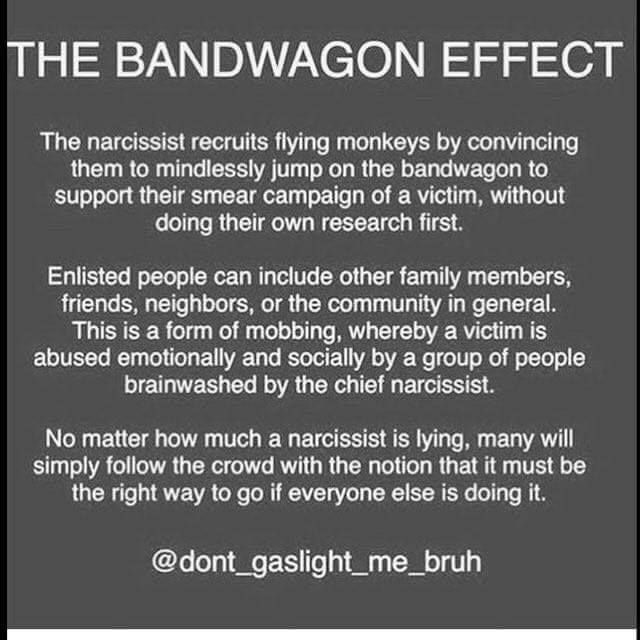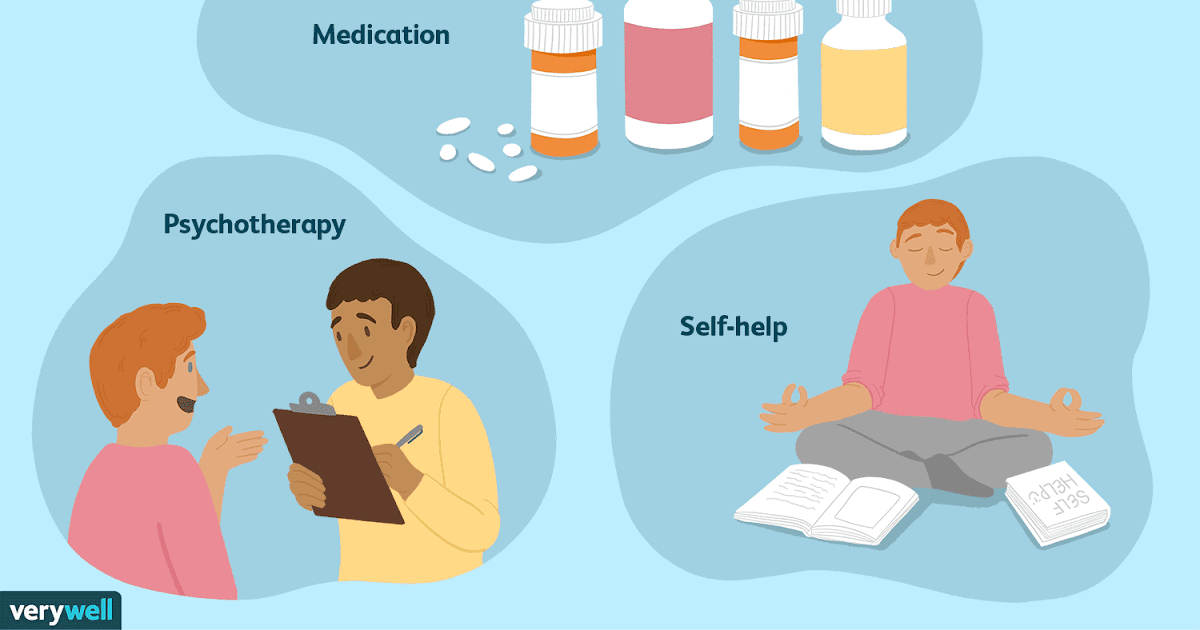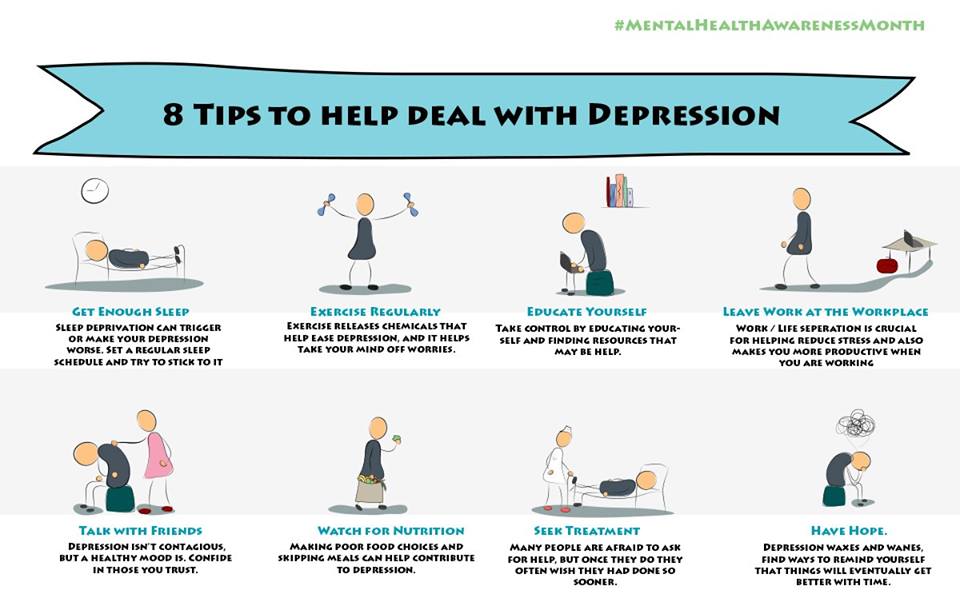Forms of narcissism
How Many Types of Narcissism are There and How Can You Identify Them?
As a personality trait, narcissism can be overt, covert, antagonistic, communal, or malignant. As a mental health condition, there’s only one diagnosis.
When you look at narcissism as a trait in terms of how it affects your day-to-day life and ability to form relationships, there are two types of narcissism:
- adaptive (helpful)
- maladaptive (unhelpful)
Some research suggests it could be more accurate to view narcissism as on a spectrum from less to more severe narcissistic traits.
You might then imagine that the different types of narcissism fit somewhere along that spectrum.
In general, narcissism is closely tied to:
- extreme self-focus
- an inflated sense of self
- a strong desire for recognition and praise
Learning about these and other narcissistic traits and narcissism types may also help you understand more about the thought processes, emotions, and behavioral patterns that tend to show up with narcissism.
Narcissism as a personality trait vs. personality disorder
When people talk about narcissism, they might be referring to it either as a part of someone’s personality or as narcissistic personality disorder (NPD).
Narcissistic personality disorder is a formal mental health diagnosis, and there’s only one type. This condition is usually diagnosed when narcissism extends beyond a personality trait and persistently affects many areas of your life. There are 9 symptoms of narcissistic personality.
But, researchers and other experts on narcissism have found multiple ways narcissism can show up as part of someone’s personality, including those with the formal diagnosis, and that’s what we’ll be talking about here.
Some research draws a line between two types of narcissism: adaptive and maladaptive narcissism. This helps to show the difference between productive and unproductive aspects of narcissism.
- Adaptive narcissism refers to aspects of narcissism that can actually be helpful, like high self-confidence, self-reliance, and the ability to celebrate yourself.

- Maladaptive narcissism is connected to traits that don’t serve you and can negatively impact how you relate to yourself and others. For example, entitlement, aggression, and the tendency to take advantage of others. This would be associated with symptoms of narcissistic personality disorder.
When most people talk about narcissism, they usually refer to the types of narcissism under the maladaptive umbrella.
Researchers and experts typically work around five types of narcissism:
- overt narcissism
- covert narcissism
- antagonistic narcissism
- communal narcissism
- malignant narcissism
Overt narcissism is also known by several other names, including grandiose narcissism and agentic narcissism.
This type of narcissism is what most people associate with a narcissistic personality.
Someone with overt narcissism might come across as:
- outgoing
- arrogant
- entitled
- overbearing
- having an exaggerated self-image
- needing to be praised and admired
- exploitative
- competitive
- lacking empathy
Some research connects overt narcissism with the Big Five personality traits of extraversion and openness.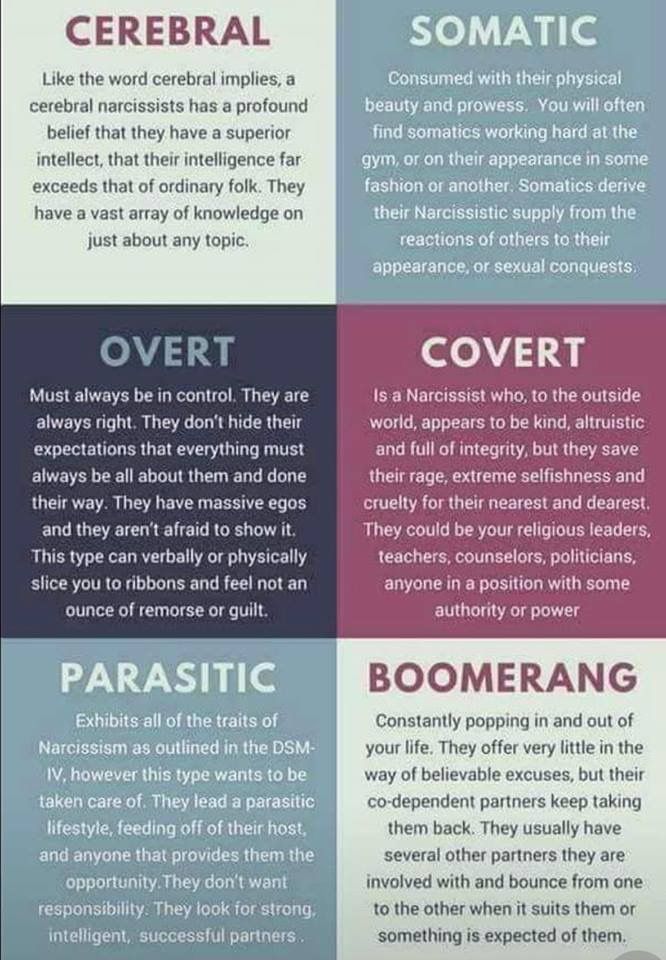
It also suggests people with overt narcissism are more likely to feel good about themselves and less likely to experience uncomfortable emotions like sadness, worry, or loneliness.
People with overt narcissism may also tend to overestimate their own abilities and intelligence.
One study published in 2018 also suggests overt narcissism might cause someone to overestimate their own emotional intelligence.
Also known as vulnerable narcissism and closet narcissism, covert narcissism is the contrast to overt narcissism.
While many people think of narcissism as a loud and overbearing trait, people with covert narcissism don’t fit this pattern.
Instead, some common traits of someone with covert narcissism include:
- expressions of low self-esteem
- higher likelihood of experiencing anxiety, depression, and shame
- introversion
- insecurity or low confidence
- defensiveness
- avoidance
- tendency to feel or play the victim
While someone with covert narcissism will still be very self-focused, this is likely to conflict with a deep fear or sense of not being enough.
A study on personality and covert narcissism published in 2017 found that it was most strongly linked to high neuroticism (tendency to experience unpleasant emotions) and disagreeableness.
Someone with covert narcissism is likely to have a hard time accepting criticism. But unlike a person with overt narcissism, someone with covert narcissism may be more likely to internalize or take in the criticism more harshly than it was intended.
Research suggests the categories of covert and overt narcissism aren’t always mutually exclusive. In other words, someone with overt narcissism might go through a period where they show more signs of covert narcissism, for example.
According to some research, antagonistic narcissism is a subtype of overt narcissism. With this aspect of narcissism, the focus is on rivalry and competition.
Some features of antagonistic narcissism include:
- arrogance
- tendency to take advantage of others
- tendency to compete with others
- disagreeability or proneness to arguing
According to research from 2017 about facets of narcissism and forgiveness, those with antagonistic narcissism reported they were less likely to forgive others than people with other types of narcissism.
People with antagonistic narcissism may also have lower levels of trust in others, according to a 2019 study.
Communal narcissism is another type of overt narcissism, and it’s usually seen as the opposite of antagonistic narcissism.
Someone with communal narcissism values fairness and is likely to see themselves as altruistic, but research published in 2018 suggests there’s a gap between these beliefs and the person’s behavior.
People with communal narcissism might:
- become easily morally outraged
- describe themselves as empathetic and generous
- react strongly to things they see as unfair
So what makes communal narcissism different from genuine concern for the well-being of others? The key difference is that for people with communal narcissism, social power and self-importance are playing major roles.
For example, while communal narcissism might cause you to say (and believe) you have a strong moral code or care for others, you might not realize the way you treat others doesn’t match up with your beliefs.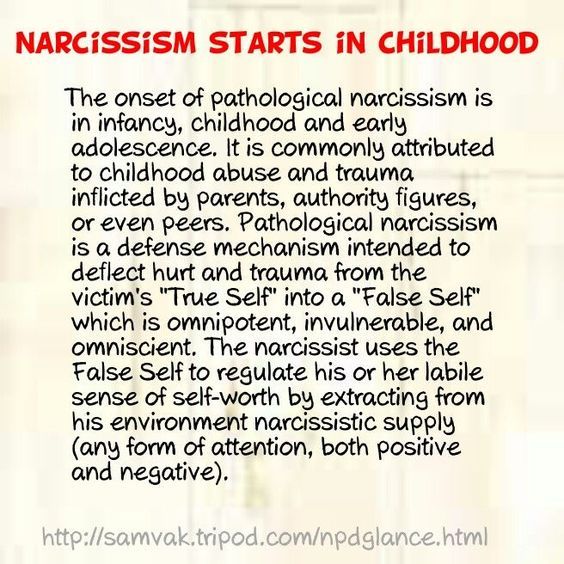
Narcissism can exist at different levels of severity, and malignant narcissism is a more severe form. It can also cause more problems for the person living with it.
Malignant narcissism is more closely connected to overt than covert narcissism.
Someone with malignant narcissism may have many common traits of narcissism, like a strong need for praise and to be elevated above others. But in addition, malignant narcissism can show up as:
- vindictiveness
- sadism, or getting enjoyment from the pain of others
- aggression when interacting with other people
- paranoia, or heightened worry about potential threats
Someone with malignant narcissism may also share some traits with antisocial personality disorder. This means someone with malignant narcissism could be more likely to experience legal trouble or substance use disorder.
In a small study involving people with borderline personality disorder (BPD), those with malignant narcissism had a harder time reducing anxiety and gaining a better ability to function in day-to-day life.
Experts work with five main types of narcissism: overt, covert, communal, antagonistic, and malignant narcissism. They can all affect how you see yourself and interact with others.
When it comes to treatment, narcissism can be tricky because many people living with it don’t necessarily feel the need to change.
But living with narcissism does pose its own mental health effects, including anxiety, depression, and substance use — and sometimes the impact of these effects causes the person to reach out for help.
When someone living with narcissism seeks professional support, there’s a lot of potential for growth and improved mental health.
If mental health care for narcissism sounds like something that could be helpful for you, you can learn more about your options here.
The 6 Types of Narcissistic Personality Disorder—Talkspace
While any one of us can display narcissistic behaviors from time to time, people with narcissistic personality disorder (NPD) have near-continuous or constant feelings of superiority and self-importance that significantly impact their lives and relationships.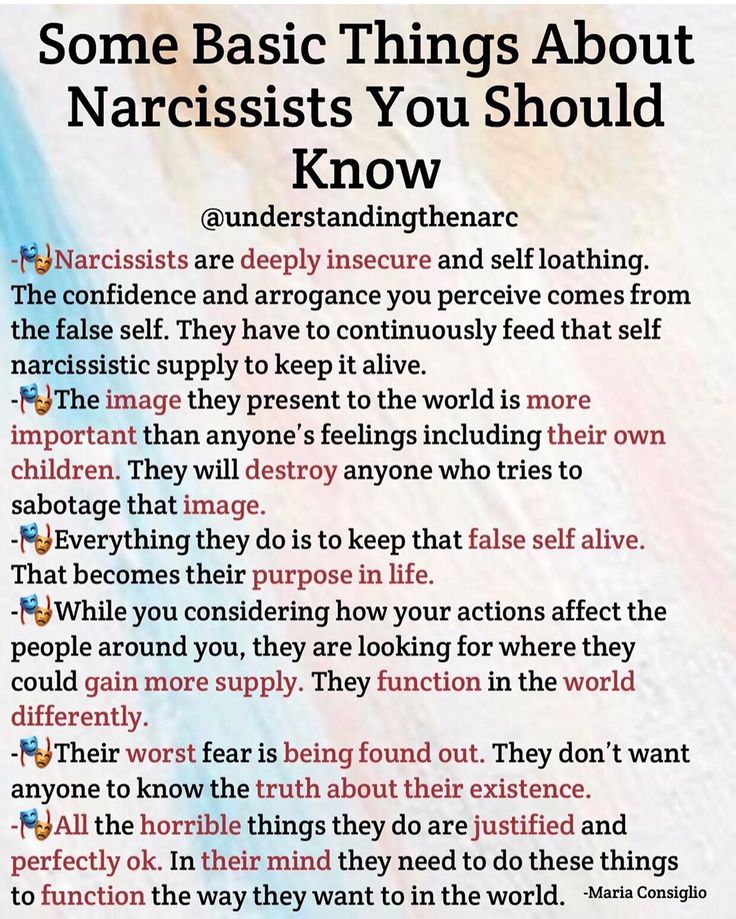
NPD is a challenging personality disorder that can cause you to obsess over things like becoming more successful or powerful than others. It might result in a constant craving for admiration, or in feelings that you’re entitled, or that you deserve special treatment in life.
All people with NPD have narcissistic traits, but that doesn’t mean that everyone with NPD behaves in the same way. There are different narcissistic personality disorder types that display unique characteristics. Knowing what to look for and how to distinguish between the various types can help you learn to deal with someone who has NPD in a healthier, more productive manner.
Here, we’re discussing the 2 main narcissistic personality disorder types. We’ll also look closely at 4 other types of people with narcissistic tendencies you may encounter in life.
What Are the Different Types of Narcissism?
There are 2 main types of narcissism: grandiose and vulnerable. Although both types share some traits, they also result in fairly distinct behaviors.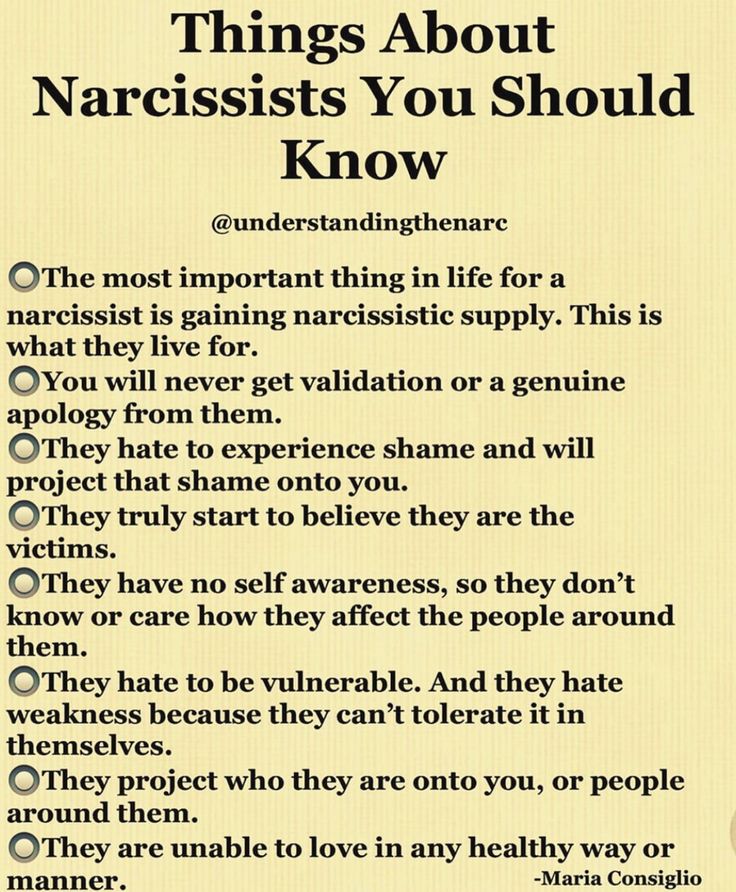
In addition to these types of NPD, there are other subtypes of narcissism. It can be helpful to think of NPD as a spectrum that includes shared behaviors as well as some notable differences. We’ll look more closely at each below.
“It’s important to recognize that narcissism can be seen in a few different ways. Not all people you meet who have narcissistic traits will have narcissistic personality disorder. People can present as either grandiose or vulnerable narcissists, which impacts their relationships differently.”
Talkspace therapist Jill E. Daino, LCSW-R
Grandiose (also known as agentic and overt narcissism)
Narcissism is often seen in a negative light, but grandiose narcissistic personalities are typically charming and well-liked. Also known as “agentic or “overt narcissism,” people with grandiose narcissism tend to have a very high sense of self-esteem, which can cause them to overestimate their capabilities. Grandiose narcissism can make people spread flattering rumors about themselves while trying to shut down any information that contradicts their illusions of greatness.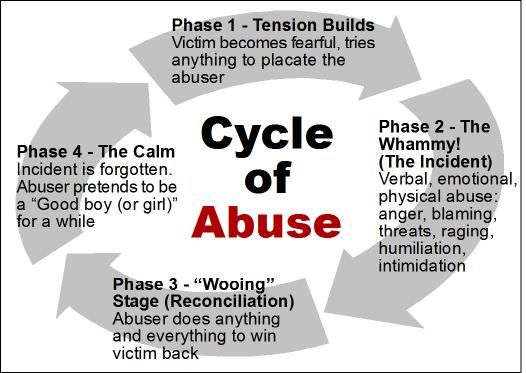
Experts believe that there are two categories of grandiose narcissism: adaptive and maladaptive.
Adaptive narcissism causes people to build up their self-confidence in order to protect themselves. They’re natural leaders and are often drawn to careers that offer positions in leadership. They crave authority and prestige.
Maladaptive narcissism means someone will have a naturally high self-esteem and believe that they’re entitled to take advantage of other people. This causes them to try to control or manipulate those around them. They may become angry or aggressive when someone disagrees with them or tries to set boundaries.
Vulnerable (also known as closet or covert narcissism)
It’s commonly assumed that narcissism causes people to want to be the center of attention, but vulnerable narcissism typically results in behaviors that are introverted and withdrawn.
Vulnerable narcissism is also referred to as “closet” or “covert narcissism,” and it would generally be seen in someone who has a low sense of self-worth and craves praise and admiration so they can feel better about themselves.
Vulnerable narcissistic personality disorder types often have elaborate fantasies of becoming successful. They believe that they deserve positive feedback from others, but usually won’t take steps to earn that praise. The lack of recognition can lead to emotional outbursts, which may cause them to feel intense levels of shame. A common personality trait of vulnerable narcissism is playing the victim.
Research shows that vulnerable narcissism means someone is more likely to experience negative emotions, and they also may perceive compliments as insults. It’s also linked to high levels of neuroticism.
It’s common for people living with this type of narcissism to struggle with depression and paranoia. They’re often envious of the people around them and tend to blame others for their lack of success.
One important note is that studies show grandiose and vulnerable narcissism aren’t always mutually exclusive of one another. Personalities may fluctuate back and forth during various periods of time.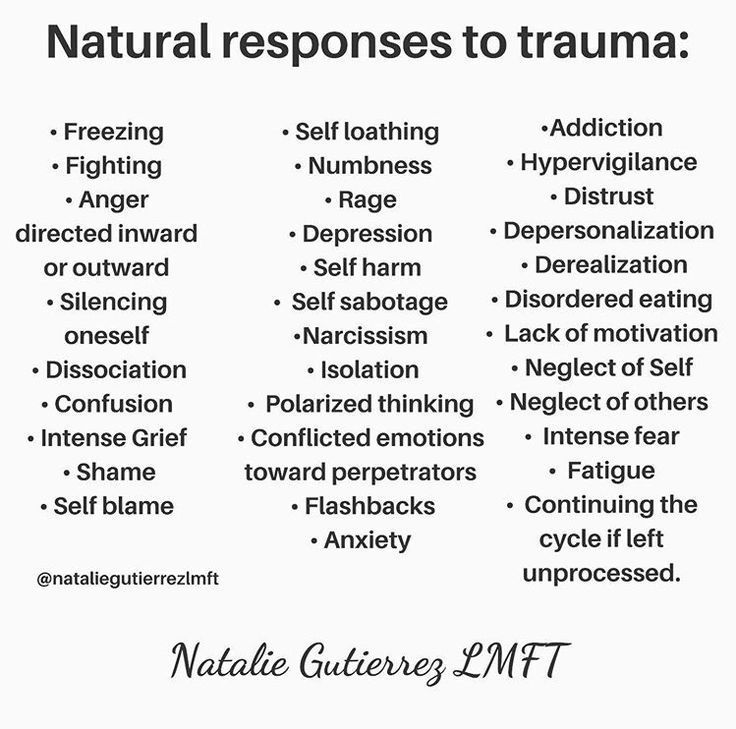
4 More Types of People You Might Come Across”
Most people with NPD fall into the grandiose or vulnerable categories, but there are other types of narcissistic personality disorders to be aware of, too.
Communal
A common trait between many types of narcissistic personality disorders is a gap between the way one views themself and how one behaves. People with communal NPD perceive themselves as highly generous and altruistic, but behave in the opposite way. While they may become outraged when they witness injustice or see someone being mistreated, they don’t apply that same level of scrutiny to their own behavior.
Antagonistic
Competitiveness is a personality trait that’s associated with many narcissistic personality disorder types, but it’s especially noticeable in those with antagonistic NPD. A low level of trust in others creates a tendency to see the people around them as rivals. It’s common for people with antagonistic NPD to argue with others and treat most social interactions as a competition.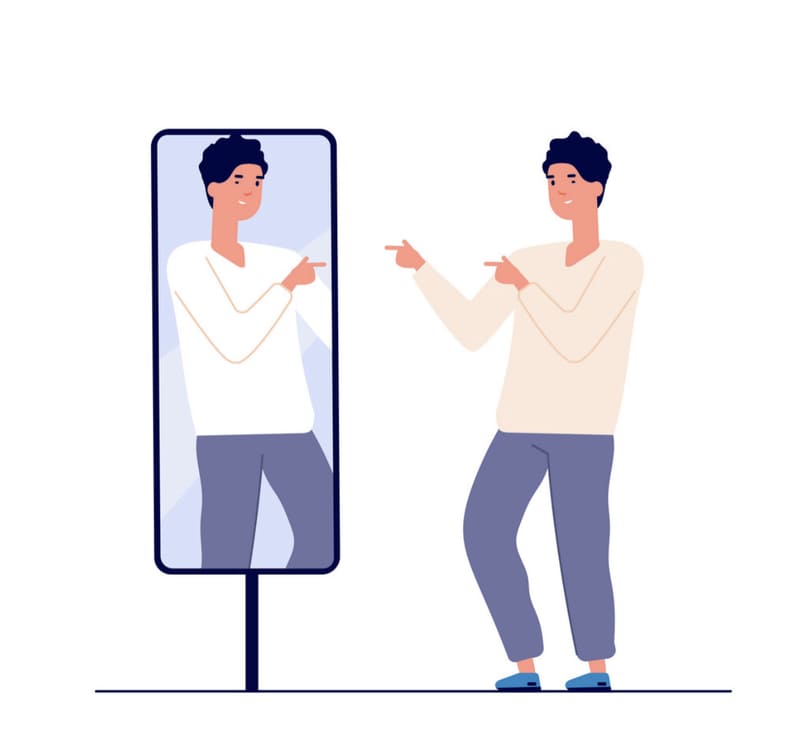
Malignant
The narcissistic personality disorder symptoms of malignant narcissism are severe and can interfere with a person’s quality of life. They’re often paranoid and may obsess over perceived threats. It’s common for them to display vindictive or even sadistic behavior and show high levels of aggression when interacting with others.
Seductive
People with seductive NPD understand the power of flattery. Like some other types of NPD, this version makes someone crave positive attention. They’ll freely shower targets with compliments in order to get the admiration they desire. When they’re not getting enough praise from someone, they have no problem dropping that person and moving on to a new target.
“You will encounter challenging people throughout your life. Not all of them will have the degree of narcissism that constitutes narcissistic personality disorder, but they might have many of the narcissistic characteristics described. Knowing how to navigate these personalities and keep your boundaries steady is crucial in dealing with narcissism. ”
”
Talkspace therapist Jill E. Daino, LCSW-R
How to Treat Different Types of Narcissism
When it comes to how to help a person diagnosed with narcissisc personality disorder, it can be difficult to persuade people with narcissistic personality disorder to get the help they need. People with NPD often harbor a belief that nothing’s wrong with them. They will likely see any encouragement to seek treatment as misguided or absurd.
“While it might seem counterintuitive to think someone diagnosed with NPD narcissist would seek help, it’s important to know that therapy can help people who want to work on how narcissism is negatively impacting their lives and relationships.”
Talkspace therapist Jill E. Daino, LCSW-R
If they can be convinced to start care, however, NPD treatment can have a very positive impact on someone with NPD’s life and relationships. One study found that 60% of people with narcissistic personality disorder had a significant reduction in symptoms 3 years after starting NPD treatment.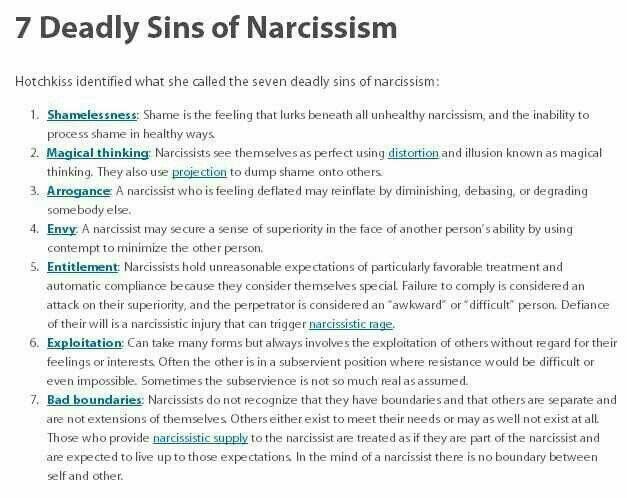
When it comes to treating narcissistic personality disorder, the primary form of treatment is psychotherapy. Working with a therapist can help people learn how to deal with narcissistic personality disorder and become more empathetic and improve their relationships with others. Therapy for narcissistic personality disorder can also teach people ways to build self-worth without needing constant recognition from others.
Because it can create significant conflicts in interpersonal relationships, family or couples counseling can focus on recognizing the harm NPD has caused, strengthening personal relationships, and changing the way someone’s been treating others.
Although there is no true narcissistic personality disorder medication, some people with NPD benefit from both therapy and medication like antidepressants and mood stabilizers.
All narcissistic personality disorder types can benefit greatly from professional treatment. Many people with NPD aren’t aware of their harmful behaviors, and psychotherapy can offer awareness and coping skills.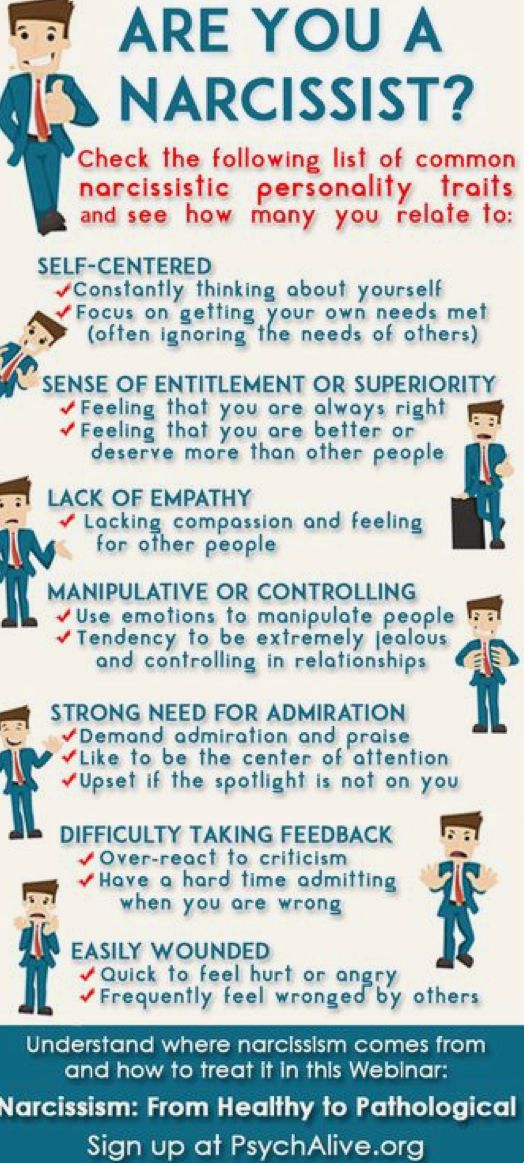 If you or someone you care about has symptoms of NPD, reach out for help today. You don’t have to live like this.
If you or someone you care about has symptoms of NPD, reach out for help today. You don’t have to live like this.
Talkspace is an online therapy platform that connects you with a certified mental health professional so you can get the treatment you deserve to manage your symptoms. Experience the most convenient, affordable way to improve your mental health. Start today.
See references
- Hill R, Yousey G. Adaptive and maladaptive narcissism among university faculty, clergy, politicians, and librarians.
- Wright A, Stepp S, Scott L et al. The effect of pathological narcissism on interpersonal and affective processes in social interactions.
- Miller J, Lynam D, Vize C et al. Vulnerable Narcissism Is (Mostly) a Disorder of Neuroticism.
- Jauk E, Weigle E, Lehmann K, Benedek M, Neubauer A. The Relationship between Grandiose and Vulnerable (Hypersensitive) Narcissism.
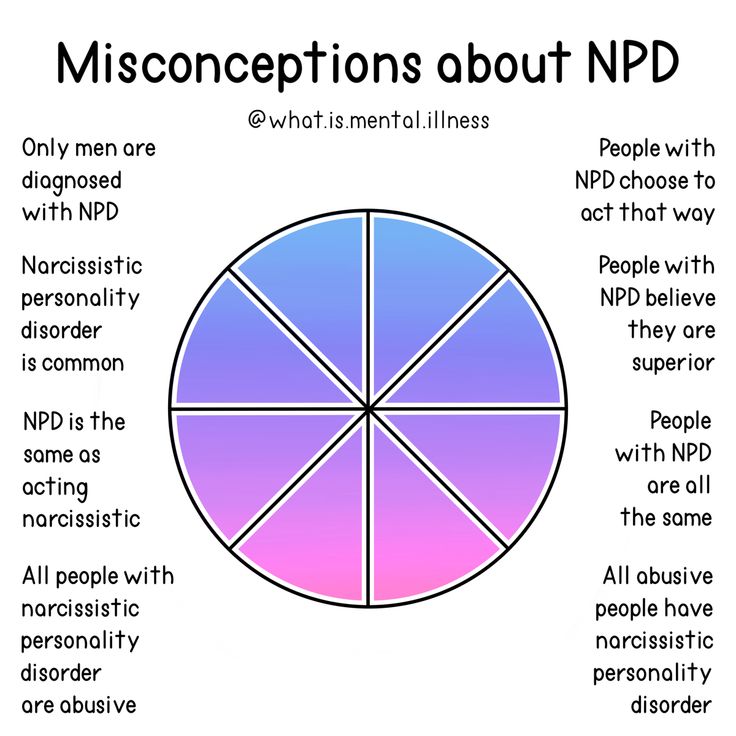 Front Psychol.
Front Psychol. - Yang Z, Sedikides C, Gu R et al. Communal narcissism: Social decisions and neurophysiological reactions.
- Kwiatkowska M, Jułkowski T, Rogoza R, Żemojtel-Piotrowska M, Fatfouta R. Narcissism and trust: Differential impact of agentic, antagonistic, and communal narcissism.
- Changes in pathological narcissism. American Journal of Psychiatry.
6 types of narcissism: what kind of narcissism is useful and what should be avoided
Traits characteristic of narcissists are especially common among successful businessmen and top managers. Although such people can be difficult to work with, they manage to easily gather followers around them, they quickly climb the career ladder and receive high salaries. A study by a group of scientists from Queen's University Belfast showed that narcissists have another advantage - they cope with stress faster and suffer less depression.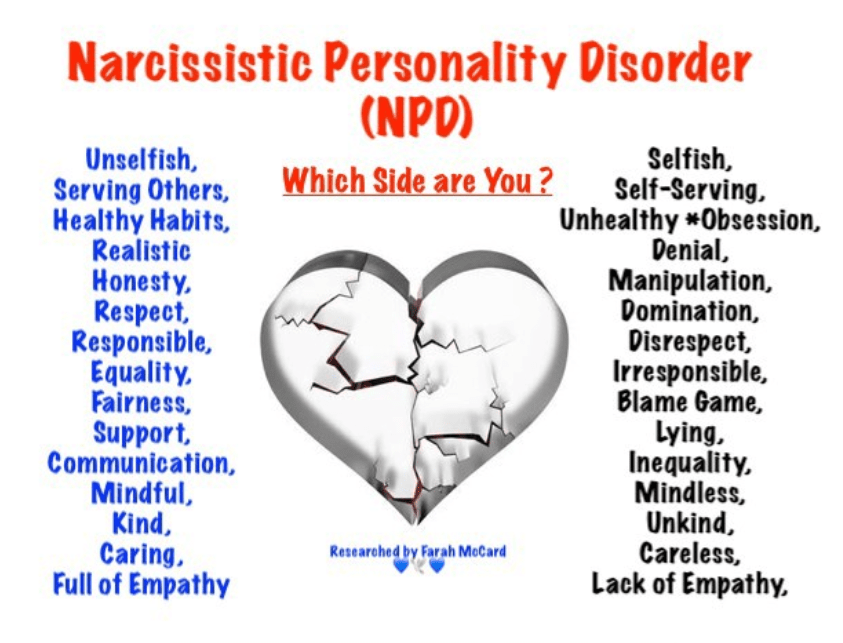 We figure out whether there is a useful narcissism and how to protect yourself from communicating with a narcissist. nine0003
We figure out whether there is a useful narcissism and how to protect yourself from communicating with a narcissist. nine0003
On the Benefits of Narcissism
Kostas Papageorgiou and colleagues rounded up 700 volunteers with signs of clinical or "normal" narcissism (this condition does not have the "dark" side of narcissistic personality disorder) and asked them a few questions about narcissism and mental toughness. All participants were divided into two categories: those who are prone to megalomania, and those who see tricks and conspiracies everywhere. It turned out that representatives of the first category are endowed with traits that help them to be successful in life: self-confidence, purposefulness and psychological endurance. These positive characteristics outweighed potentially negative emotions or stress. nine0003
The trump card of narcissists is the belief that they deserve the best in life
People who are prone to megalomania are not particularly interested in other people's opinions - therefore it is easier for them to focus on the task. At the same time, unlike the second type of narcissists (who do not trust anyone), they are prone to extraversion.
At the same time, unlike the second type of narcissists (who do not trust anyone), they are prone to extraversion.
Of course, narcissism also has negative sides (we will discuss them below), but we should not forget that the state of narcissism occurs to varying degrees in each person. The main thing is to benefit from your personality traits, and not to obey them. nine0003
Papageorgiou proposes to consider narcissism as a bridge between the "dark" (anti-social) and "light" (pro-social) sides of the personality. We can use our dark side when faced with a difficult situation, and in favorable circumstances, remain on the "light" side. Each personality should be perceived as a whole range of psychological and emotional characteristics that manifest themselves at different points in time. nine0003
6 types of narcissism
It is important to distinguish between clinical and episodic manifestations of narcissism. The clinical condition can take many forms, and although there is no single formula, take a look at the list of six dangerous types of narcissists to avoid.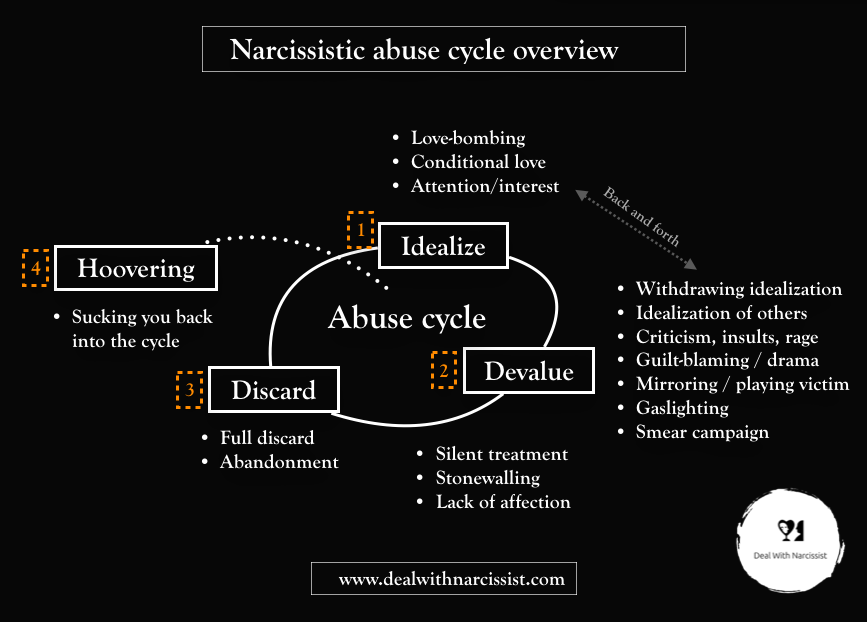
1. Toxic
The toxic narcissist is a source of continuous drama in the lives of others, causing them pain and suffering. Such a person will constantly demand attention to himself, but will never take an interest in what is happening with you. He is also prone to physical and/or psychological abuse, which does not show up right away - but once the narcissist has gained your trust. nine0003
2. Psychopath
A type of aggressive, unstable personality. Such people are arrogant and strive for power at any cost. They need constant worship and use others to achieve their goals. These are cruel, heartless people. According to clinical psychologist John Mayer, serial killers often suffer from psychopathy.
3. Secret narcissist
This type is the most difficult to recognize because such a person does not always behave like a typical narcissist, but at the same time he clearly believes in his own importance, always craves attention and reverence, is envious of others and is not very good at empathy .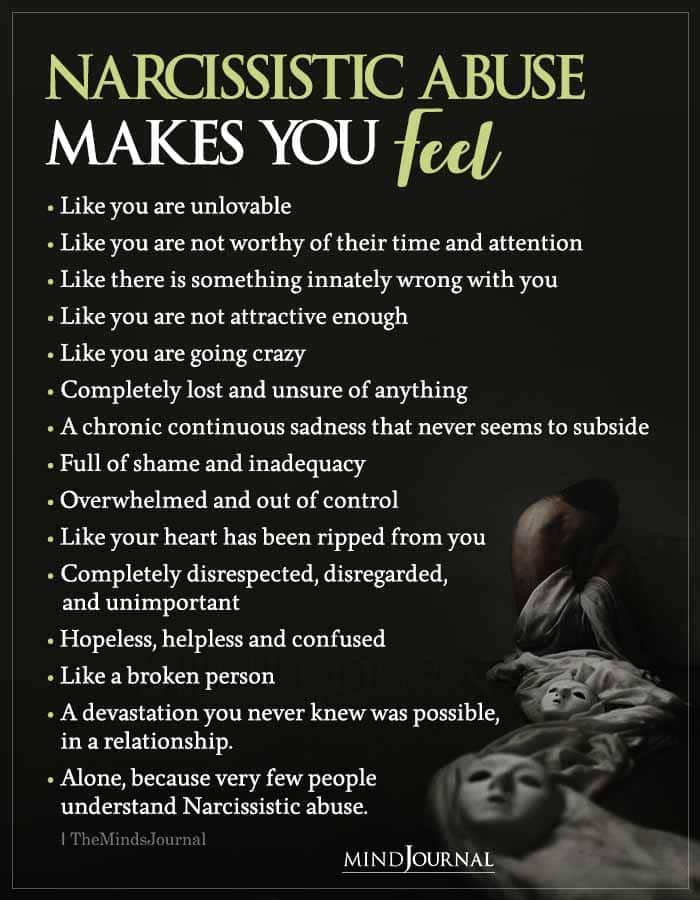 Psychotherapist Alice Ruby Bash says that such people can show themselves as ideal companions and faithful companions - give the appearance of an altruistic person, but at the same time associate themselves with a person who is admired and claims to be famous. nine0003
Psychotherapist Alice Ruby Bash says that such people can show themselves as ideal companions and faithful companions - give the appearance of an altruistic person, but at the same time associate themselves with a person who is admired and claims to be famous. nine0003
4. Exhibitionist
In contrast to the secret narcissist, the exhibitionist always behaves in such a way that everyone knows what a person thinks about himself and about others. Such a person is arrogant, arrogant and surrounds himself with henchmen. According to Bash, exhibitionists cannot go a day without public attention.
5. Abuser
This type combines two terrible features: obsession with oneself and a thirst for insults and humiliation of others. Dr Mayer says that the abuser builds his reputation on intimidation and aggression. Bullying narcissists often seek a position of power and authority at all costs. They enjoy watching others feel worthless and broken. Unlike the "regular" bully and aggressor who pursues some social benefit, the narcissist abuser insults others for his own pleasure.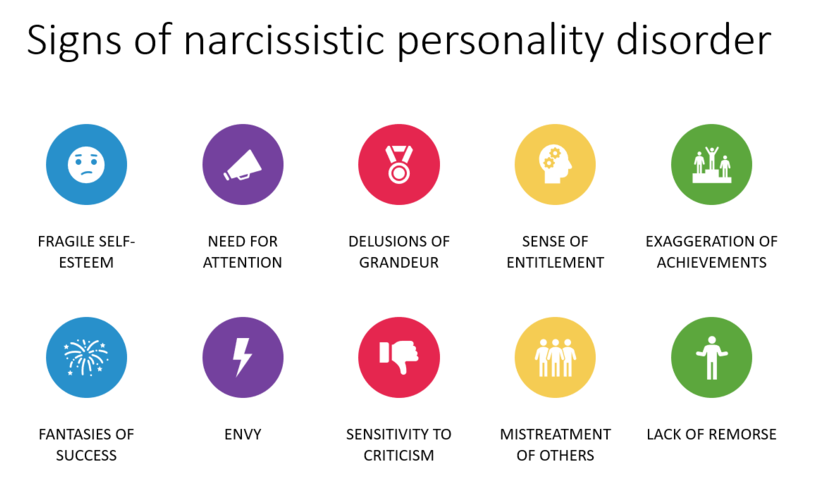 nine0003
nine0003
6. Seducer
The seducer will first surround you with attention and make you feel in seventh heaven with happiness, but as soon as you succumb to his charms and fall into a trap, he will abruptly change his tactics and destroy your peace of mind. He will manipulate you, play on your feelings and use psychological (and sometimes physical) violence.
There are 3 types of narcissism - here's how to learn to identify them
- Narcissistic personality disorder is a single diagnosis, but it combines three varieties of narcissism.
- People with these disorders are categorized based on how they interact and treat other people.
- Some experts believe that identifying a person's type of narcissism makes a relationship possible, while others believe it is the best way to keep relationships clear.
To be diagnosed with narcissistic personality disorder, a person must display at least five of the nine special characteristics. People with these disorders are characterized by low levels of empathy, an exaggerated idea of their own personality, and a need for admiration. nine0003
People with these disorders are characterized by low levels of empathy, an exaggerated idea of their own personality, and a need for admiration. nine0003
Many narcissists live by similar patterns of behavior, such as flattery, manipulativeness, and rejection of people who do not benefit them, but at the same time, they can behave very differently.
Many psychotherapists and therapists divide narcissists into three different categories based on three types of actions: openness, closeness, and toxicity.
According to Elinor Greenberg, the therapist who wrote the book Borderline, Narcissistic, and Schizoid Adaptations: The Need for Love, Admiration, and Security, the form of human narcissism is largely dependent on upbringing. nine0003
Open narcissists are a stereotype
For example, open (or pretentious) narcissists have the "look at me" mindset that children often have.
Children don't immediately learn to understand their parents' problems, "so they lack empathy in that regard," says Greenberg.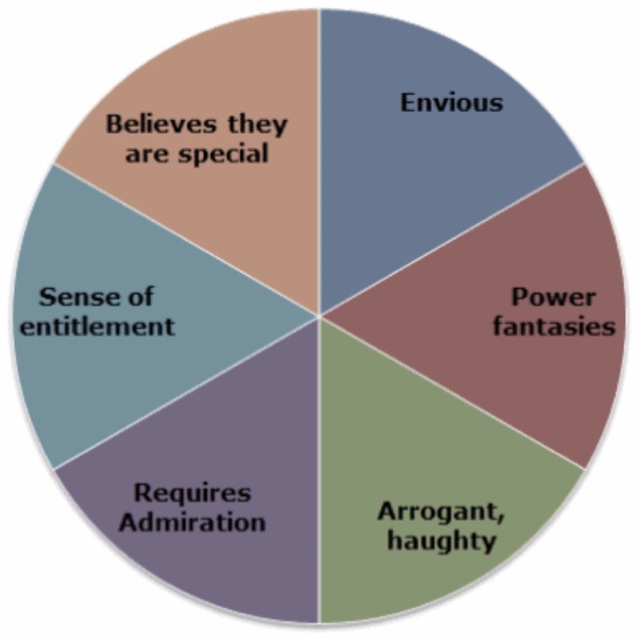 “If you outgrow this life stage with a normal level of attention, then you can overcome this barrier.”
“If you outgrow this life stage with a normal level of attention, then you can overcome this barrier.”
But some people, she says, grow up in families where children are raised in a narcissistic manner—for example, their family members may position them as special and claim that they deserve success because "it's in their blood." nine0003
An open narcissist is a stereotypical image of a narcissist, says Shannon Thomas, a licensed clinical social worker who wrote the book Covert Offense Treatment.
"They think they're incredible - they find themselves smarter, more attractive and stronger than other people and truly believe in it," she told Business Insider. "Even in the company of friends or close colleagues, they put themselves one step higher."
Open daffodils are not defenseless, says Thomas. If they do not praise themselves, then they try to humiliate someone else. Often they are rude, inconsiderate and angry towards other people. They choose to ignore or even not notice how others react to their actions. ” nine0003
” nine0003
Closed narcissists have different personalities
Some people with narcissistic personality disorder grow up to be closed narcissists in families where they have to constantly compete for love or in families where they are constantly hindered, says Greenberg, in such cases people receive approval only when they bow themselves .
Closed (or hidden) narcissists want to be special, but this causes them internal conflict. Like open narcissists, closed narcissists also consider themselves incredibly distinctive, but they are much more defenseless. nine0003
"Closed narcissists don't directly say they're special," Greenberg says. "They choose someone else—a person, a religion, a book, a fashion designer—who they think is special, and then begin to feel special by interacting with them."
She also added: “When someone feels special because of the designer things on themselves, then others define it as an associative feature. Closed narcissists are often insecure, so they look for someone they can idealize.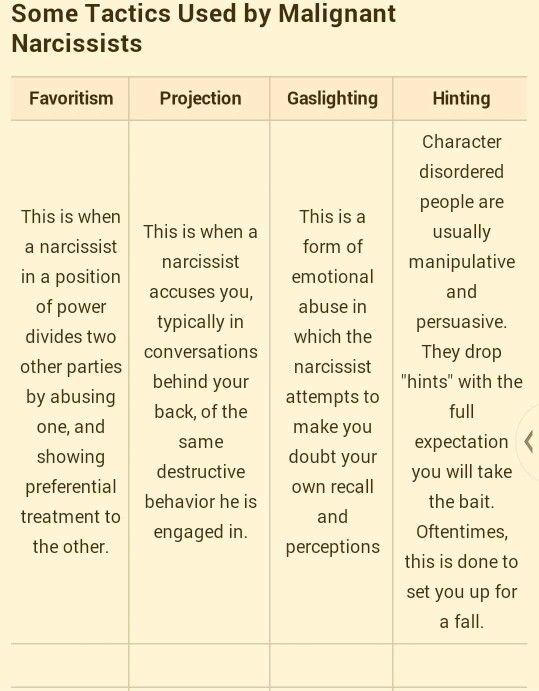 " nine0003
" nine0003
Their behavior can often be described as passive-aggressive. For example, they try to keep their love partners in constant disappointment. They may promise something and then fail to do so in order to enjoy the reaction of others.
"They do what they want, when they want," says Thomas, "and then they try to make themselves the victim."
Constantly saying one thing and doing something completely different, people with a closed type of narcissism drive people close to them crazy, forcing them to doubt the reality of what is happening and their own adequacy. Closed narcissists may blame their partners for things they never did, but partners can easily believe their words, as their own reality begins to distort. nine0003
While open narcissists are quite consistent in their actions, closed narcissists may exhibit different personality traits. In certain situations, they can behave differently - in public they can present themselves as charismatic and sweet, and in relationships with their own partners - cruel and evil, which causes them even more uncertainty.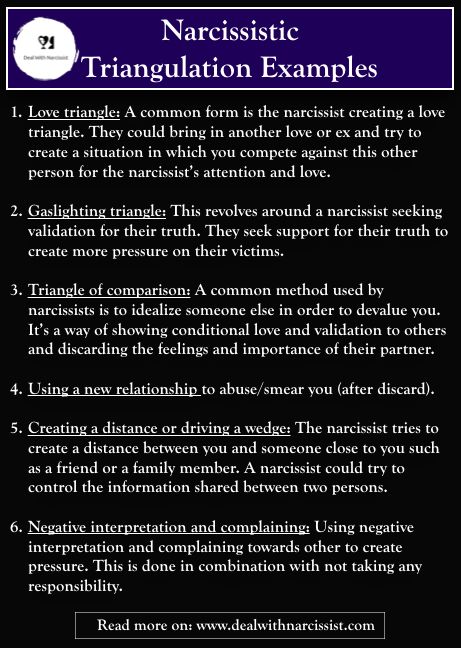
Toxic narcissists crave chaos and destruction
Toxic (or malicious) narcissists go one step higher. They not only crave attention to their own person, but also want others to feel in submission. They tend to be sadistic and enjoy the pain of others. nine0003
"Toxic daffodils are like the Ice Queen from Snow White," Greenberg says. "When the mirror says that Snow White is prettier than her, the Ice Queen decides to kill Snow White and hide her heart in a box."
Toxic narcissists find it incredibly exciting to inspire people and then watch them fail. Thomas calls this behavior an additional layer of sadistic behavior.
"This type of narcissism borders on antisocial personality disorder," she says. "People who enjoy ruining other people's careers feel great about ruining other people emotionally, physically, or spiritually." nine0003
Toxic narcissists usually have chaos around them, says Thomas, so they enjoy bringing chaos into other people's lives.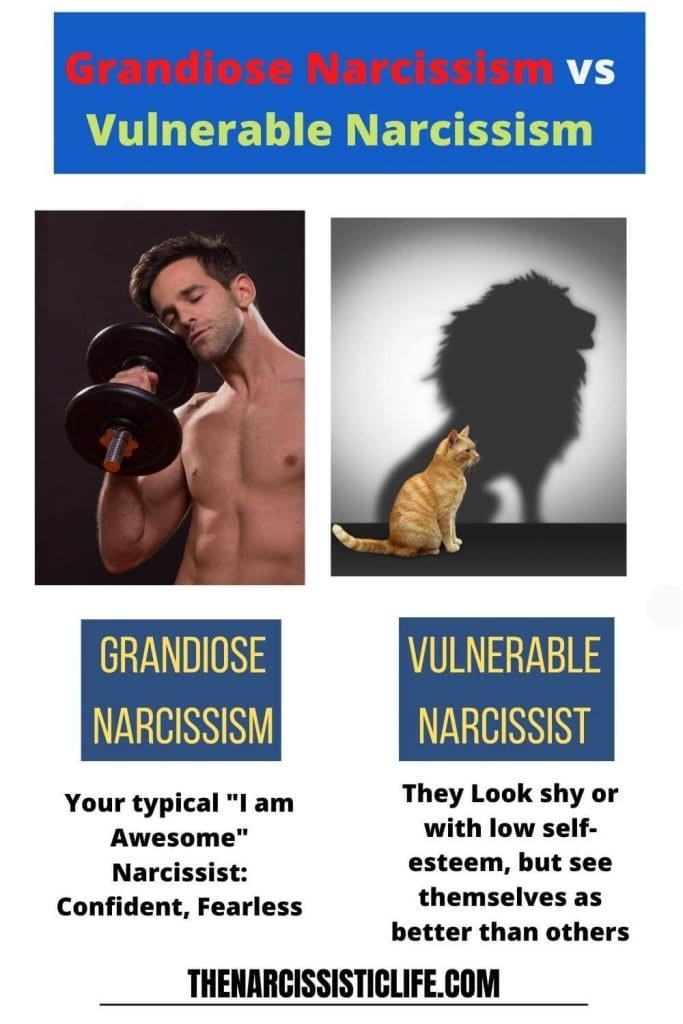
“Harmony is not their goal,” she says, “We are very worried about its abundance, but, on the contrary, they receive energy during its deficiency. That is why such people often themselves provoke problems and dramas in the lives of others. They always say they hate drama, but they always get into the middle of it.”
Relationships with narcissists can be risky
People with narcissistic personality disorder suffer from a lack of consistency. This means that, for example, when they show anger towards their partner, they do not see it in the context of the relationship and continue to show hatred or a desire to hurt their partner.
This makes relationships with narcissists - whether romantic, familial or professional - very exhausting.
Greenberg argues that it is possible to build relationships with narcissists if you identify their type of narcissism and understand how it functions. Many relationship experts, one way or another, argue that it's best to stay away from narcissists.